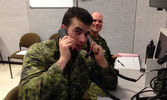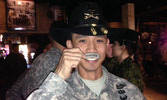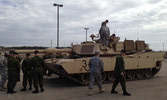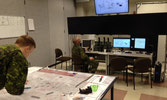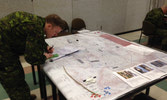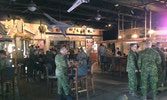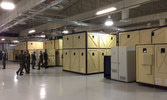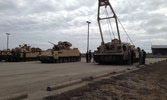Ex STEELE BEASTS – Thunder Horse meets Perseverance
Captain Alex Nitu
In August of 2014 RHQ began the initial planning of Ex STEELE BEASTS, a “Synthetic Environment” (read: virtual reality) exercise using the U.S. Army’s Close Combat Tactical Trainer (CCTT). This system replicates a square U.S. combat team of 14 x M1 MBTs and 14 x M2 IFVs in an immersive and accurate environment. The scope would see both tank squadrons and two reconnaissance troops deploy in two successive waves to Fort Hood to use the system to replicate Level 5 (combat team) manoeuvres. After diligent efforts from the Strathcona’s, 1 CMBG, 3d Cavalry Regiment (U.S.), and 12th Cavalry (U.S.) staffs, the exercise was carried out with resounding success.
An RHQ advance party deployed on 26 February to open up the real-Life support for the exercise, which included quarters (provided graciously by 3d Cavalry Regiment), the dining facility, and a final conditions check with the CCTT facility itself. The first wave arrived the weekend of 28 February, consisting of B Squadron and a troop from Reconnaissance Squadron. Monday saw the first training day pass with orientation and system familiarization. That effect was only possible due to the efforts of the CCTT Staff (headed by the site manager, Mr. Jay Rosenblum) and the soldiers and officers of 2 Bn – 12th Cavalry, which provided M1 and M2 crewmen to explain how to use their vehicles. Further 2/12 Cav provided a complete mechanized infantry company to complete the square combat team. While it took a few moments to sort out terminology and TTPs, the Canadian and American units quickly came together and worked as a unified team. The first day ended with orders being delivered by the CO for the next day’s activities.
Tuesday was the advance to contact missions, with both a simple and complex attack occurring on the digitally replicated terrain of Fort Irwin, California (their National Training Center). Minefields were crossed, and dry gaps bridged, all in the virtual space while the tank squadron led the combat team. The Ops WO, WO Rob Englehart, was the OPFOR commander and expertly led his forces against our BLUEFOR, earning several “Orders of Lenin” along the way. The tank and reconnaissance troops realised that fighting against a thinking and capable enemy is quite different than the plywood targets that typically populate Wainwright.
Wednesday was occupied by both delay and mobile defence operations, with our forces split between Canadian and American led combat teams. Despite our differences, attached U.S platoon and detached Canadian troops blended seamlessly into their respective teams, and where capably led regardless of uniform colour. Both waves learned lessons regarding the quick pace of decisions and movements required to make a delay possible, and the at-times overwhelming scale of fighting to hold back a Soviet-style mechanized infantry battalion.
Thursday’s training put us back onto the offensive, this time using the two combat teams to carry out sequenced deliberate attacks. Despite the best efforts of the Ops WO, the BLUEFOR foiled his attempts at countermoves and surprise envelopment. However, that is not to say that tank and Bradley crews escaped unscathed, many gained a new respect for T-80B gunners and long range ATGMs. Friday was the culminating mission, which began as an “Isolate” task consisting of an inner and outer cordon. After the cordons were set, and enemy breakout operations were halted, an airmobile assault was mounted to clear out the town with tank/IFV support.
B Squadron and Recce Tp flew out the weekend of 7/8 March, with A Squadron and another Recce Tp replacing them. The conduct of the subsequent week was the same, meeting with marked success as well. Other notable events across the two waves was the generous provision of a M1A2 SEP MBT, M2 A3, HMMWV, and M88 A1 during lunch hour on Thursday by 2/12 Cav so that our soldiers could see the equipment in real-life and interact with their crews. Always the gracious hosts, 2/12 Cav Commander, LTC Rockerfeller, and his Ops Staff, headed by CPT Tony Nguyen, also arranged two separate “meet and greets” for the two waves at an On Post Pub, so our two teams could interact in a social sphere. Many berets were traded for Stetsons, leading to a brisk sale of berets and cap badges on the next duty day in Edmonton.
Other notable professional development activities included: Guided tours of the 3d Cavalry museum, a walkthrough of the immense open-air historical vehicle park of the 1st Cavalry Division museum, taking part in morning PT runs alongside U.S units, and watching Capt Steve Couture try to eat 3 lbs of Smoked Brisket in one sitting (although a valiant try, he was not successful – he made it to 1.7 lbs). The second wave redeployed the weekend of 14/15 March, with the RHQ EXCON contingent departing after finalising out-clearance with 3d Cav (special thanks to LTC Croucher and CPT Wolf from 3d Cav for helping us out – without their perseverance this exercise would likely not have happened).
While nothing can replace field training, I believe that all participants see the tremendous value that synthetic environment training can provide to augment field training. Especially in times of resource restraint and vehicle serviceability, these opportunities provide an indispensable was to train and learn (sometimes hard) lessons of the unforgiving nature of manoeuvre warfare. I hope we can continue to foster these important relationships in the future.

